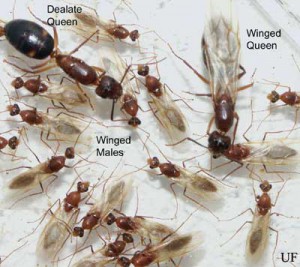The proverbial picnic scene aside, ants are pests all of us have to deal with from time to time. Both inside and outside our homes, they feed on and contaminate our food, they build ugly mounds on our lawns, and some ants can inflict painful bites or stings.
Several species of ants are found in Florida. The most common can be grouped into three categories: House-infesting ants, yard infesting ants, and carpenter ants. In this article we’ll talk about ant biology and behavior and how to control them.
Ants have a life cycle similar to many other insects. They go from egg, to larva, to pupa, to adult. Eggs are almost microscopic in size and hatch into soft legless larvae. The pupa resembles the adult ant, except it is soft, uncolored and immobile. It can take from six weeks to two months from egg to adult.
Ants are social insects. They live in colonies much like bees do. Most colonies have a queen ant, male ants, and worker or female ants. Colonies are started by queens, whose primary function is reproduction. The queen may live for many years and is usually replaced by a daughter queen. Males are produced in very old or large colonies, and their sole function is to mate with the unfertilized female, after which, they die. Worker ants construct, repair and defend the nest, provide food for the colony, and take care of the young ants.
Most ants are omnivorous, which means they will eat anything, through some do have specialized food habits. Ants locate food by random searching; when one ant finds food, she informs the other workers in the colony. The exact method of communication is unknown, but in some cases, ants can leave scent trails that other ants can follow to the food source.
Because ants are attracted to any type of food or food particles, your best bet to controlling ants inside your home is to keep it very clean. Store food in airtight containers. Never substitute insecticides for inadequate housekeeping.
The key to eliminating ants is locating and destroying the colony. Sometimes this can be a real problem, because ants are very adaptable. Outdoor nesting species can sometime nest indoors and vice versa, depending, on the food supply.
To find the ant colony, you have to watch the movement of the ants very closely. Outdoors, many ants are easy to locate, because they deposit earth on the soil surface, and form ant hills. But some outdoor ants build nests under house foundations, in decaying logs, and tree trunks. These can be difficult to locate indoors. Ants may nest in walls, behind baseboards, in cracks, and in decaying wood.
Spray, dusts, granules, and baits can be useful in controlling ants. When using these products, treat baseboards, door and window frames, and cracks and crevices between walls and flooring. Treat all areas where ants appear to have trails. If the nest is located, apply an insecticide to the nest according to the pesticide label.
For more information:
- Muscadine Grape: a Popular Fruit for North Florida - August 10, 2015
- Southern Field Peas, a Summer Delight - July 14, 2015
- Caterpillars with a Sting - June 10, 2015

